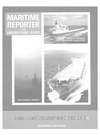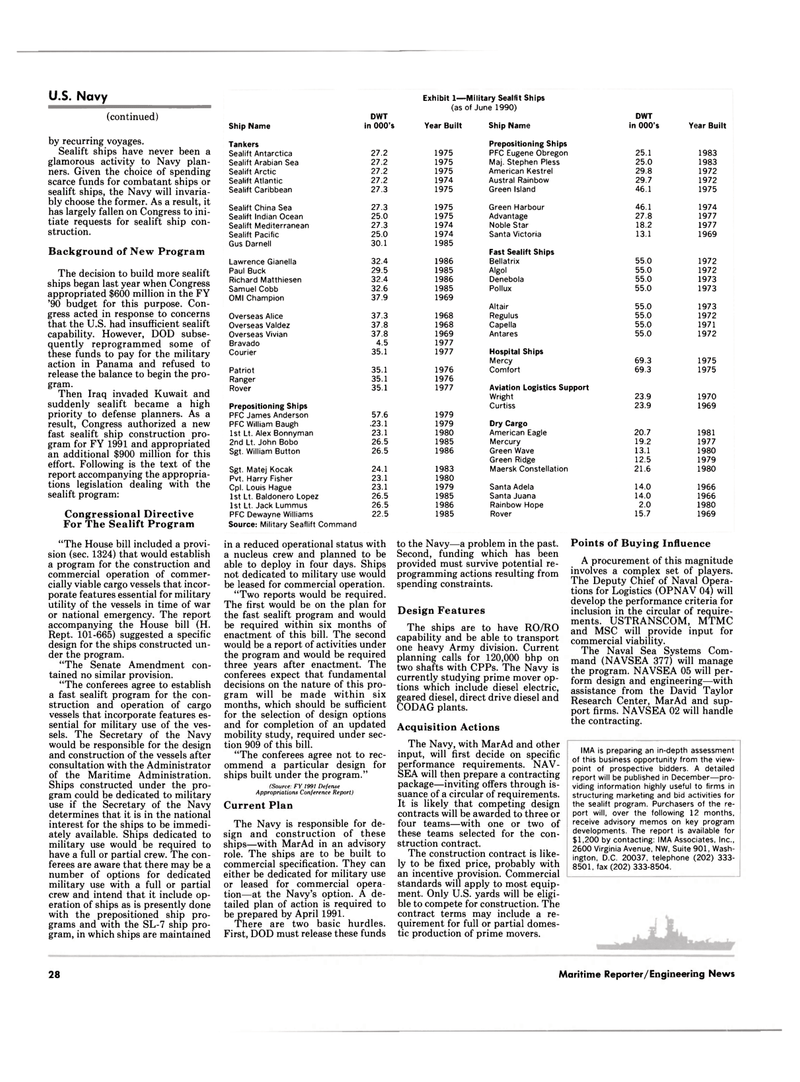
Page 26: of Maritime Reporter Magazine (December 1990)
Read this page in Pdf, Flash or Html5 edition of December 1990 Maritime Reporter Magazine
U.S. Navy (continued) by recurring voyages.
Sealift ships have never been a glamorous activity to Navy plan- ners. Given the choice of spending scarce funds for combatant ships or sealift ships, the Navy will invaria- bly choose the former. As a result, it has largely fallen on Congress to ini- tiate requests for sealift ship con- struction.
Background of New Program
The decision to build more sealift ships began last year when Congress appropriated $600 million in the FY '90 budget for this purpose. Con- gress acted in response to concerns that the U.S. had insufficient sealift capability. However, DOD subse- quently reprogrammed some of these funds to pay for the military action in Panama and refused to release the balance to begin the pro- gram.
Then Iraq invaded Kuwait and suddenly sealift became a high priority to defense planners. As a result, Congress authorized a new fast sealift ship construction pro- gram for FY 1991 and appropriated an additional $900 million for this effort. Following is the text of the report accompanying the appropria- tions legislation dealing with the sealift program:
Congressional Directive
For The Sealift Program "The House bill included a provi- sion (sec. 1324) that would establish a program for the construction and commercial operation of commer- cially viable cargo vessels that incor- porate features essential for military utility of the vessels in time of war or national emergency. The report accompanying the House bill (H.
Rept. 101-665) suggested a specific design for the ships constructed un- der the program. "The Senate Amendment con- tained no similar provision. "The conferees agree to establish a fast sealift program for the con- struction and operation of cargo vessels that incorporate features es- sential for military use of the ves- sels. The Secretary of the Navy would be responsible for the design and construction of the vessels after consultation with the Administrator of the Maritime Administration.
Ships constructed under the pro- gram could be dedicated to military use if the Secretary of the Navy determines that it is in the national interest for the ships to be immedi- ately available. Ships dedicated to military use would be required to have a full or partial crew. The con- ferees are aware that there may be a number of options for dedicated military use with a full or partial crew and intend that it include op- eration of ships as is presently done with the prepositioned ship pro- grams and with the SL-7 ship pro- gram, in which ships are maintained
Exhibit 1—Military Sealfit Ships (as of June 1990)
DWT DWT
Ship Name in 000's Year Built Ship Name in 000's Year Built
Tankers Prepositioning Ships
Sealift Antarctica 27.2 1975 PFC Eugene Obregon 25.1 1983
Sealift Arabian Sea 27.2 1975 Maj. Stephen Pless 25.0 1983
Sealift Arctic 27.2 1975 American Kestrel 29.8 1972
Sealift Atlantic 27.2 1974 Austral Rainbow 29.7 1972
Sealift Caribbean 27.3 1975 Green Island 46.1 1975
Sealift China Sea 27.3 1975 Green Harbour 46.1 1974
Sealift Indian Ocean 25.0 1975 Advantage 27.8 1977
Sealift Mediterranean 27.3 1974 Noble Star 18.2 1977
Sealift Pacific 25.0 1974 Santa Victoria 13.1 1969
Gus Darnell 30.1 1985
Fast Sealift Ships
Lawrence Gianella 32.4 1986 Bellatrix 55.0 1972
Paul Buck 29.5 1985 Algol 55.0 1972
Richard Matthiesen 32.4 1986 Denebola 55.0 1973
Samuel Cobb 32.6 1985 Pollux 55.0 1973
OMI Champion 37.9 1969
Altair 55.0 1973
Overseas Alice 37.3 1968 Regulus 55.0 1972
Overseas Valdez 37.8 1968 Capella 55.0 1971
Overseas Vivian 37.8 1969 Antares 55.0 1972
Bravado 4.5 1977
Courier 35.1 1977 Hospital Ships
Mercy 69.3 1975
Patriot 35.1 1976 Comfort 69.3 1975
Ranger 35.1 1976
Rover 35.1 1977 Aviation Logistics Support
Wright 23.9 1970
Prepositioning Ships Curtiss 23.9 1969
PFC James Anderson 57.6 1979
PFC William Baugh .23.1 1979 Dry Cargo 1st Lt. Alex Bonnyman 23.1 1980 American Eagle 20.7 1981 2nd Lt. John Bobo 26.5 1985 Mercury 19.2 1977
Sgt. William Button 26.5 1986 Green Wave 13.1 1980
Green Ridge 12.5 1979
Sgt. Matej Kocak 24.1 1983 Maersk Constellation 21.6 1980
Pvt. Harry Fisher 23.1 1980
Cpl. Louis Hague 23.1 1979 Santa Adela 14.0 1966 1st Lt. Baldonero Lopez 26.5 1985 Santa Juana 14.0 1966 1st Lt. Jack Lummus 26.5 1986 Rainbow Hope 2.0 1980
PFC Dewayne Williams 22.5 1985 Rover 15.7 1969
Source: Military Seaflift Command in a reduced operational status with a nucleus crew and planned to be able to deploy in four days. Ships not dedicated to military use would be leased for commercial operation. "Two reports would be required.
The first would be on the plan for the fast sealift program and would be required within six months of enactment of this bill. The second would be a report of activities under the program and would be required three years after enactment. The conferees expect that fundamental decisions on the nature of this pro- gram will be made within six months, which should be sufficient for the selection of design options and for completion of an updated mobility study, required under sec- tion 909 of this bill. "The conferees agree not to rec- ommend a particular design for ships built under the program." (Source: FY 1991 Defense
Appropriations Conference Report)
Current Plan
The Navy is responsible for de- sign and construction of these ships—with MarAd in an advisory role. The ships are to be built to commercial specification. They can either be dedicated for military use or leased for commercial opera- tion—at the Navy's option. A de- tailed plan of action is required to be prepared by April 1991.
There are two basic hurdles.
First, DOD must release these funds to the Navy—a problem in the past.
Second, funding which has been provided must survive potential re- programming actions resulting from spending constraints.
Design Features
The ships are to have RO/RO capability and be able to transport one heavy Army division. Current planning calls for 120,000 bhp on two shafts with CPPs. The Navy is currently studying prime mover op- tions which include diesel electric, geared diesel, direct drive diesel and
CODAG plants.
Acquisition Actions
The Navy, with MarAd and other input, will first decide on specific performance requirements. NAV-
SEA will then prepare a contracting package—inviting offers through is- suance of a circular of requirements.
It is likely that competing design contracts will be awarded to three or four teams—with one or two of these teams selected for the con- struction contract.
The construction contract is like- ly to be fixed price, probably with an incentive provision. Commercial standards will apply to most equip- ment. Only U.S. yards will be eligi- ble to compete for construction. The contract terms may include a re- quirement for full or partial domes- tic production of prime movers.
Points of Buying Influence
A procurement of this magnitude involves a complex set of players.
The Deputy Chief of Naval Opera- tions for Logistics (OPNAV 04) will develop the performance criteria for inclusion in the circular of require- ments. USTRANSCOM, MTMC and MSC will provide input for commercial viability.
The Naval Sea Systems Com- mand (NAVSEA 377) will manage the program. NAVSEA 05 will per- form design and engineering—with assistance from the David Taylor
Research Center, MarAd and sup- port firms. NAVSEA 02 will handle the contracting.
IMA is preparing an in-depth assessment of this business opportunity from the view- point of prospective bidders. A detailed report will be published in December—pro- viding information highly useful to firms in structuring marketing and bid activities for the sealift program. Purchasers of the re- port will, over the following 12 months, receive advisory memos on key program developments. The report is available for $1,200 by contacting: IMA Associates, Inc., 2600 Virginia Avenue, NW, Suite 901, Wash- ington, D C. 20037. telephone (202) 333- 8501, fax (202) 333-8504. 28 Maritime Reporter/Engineering News

 25
25

 27
27
